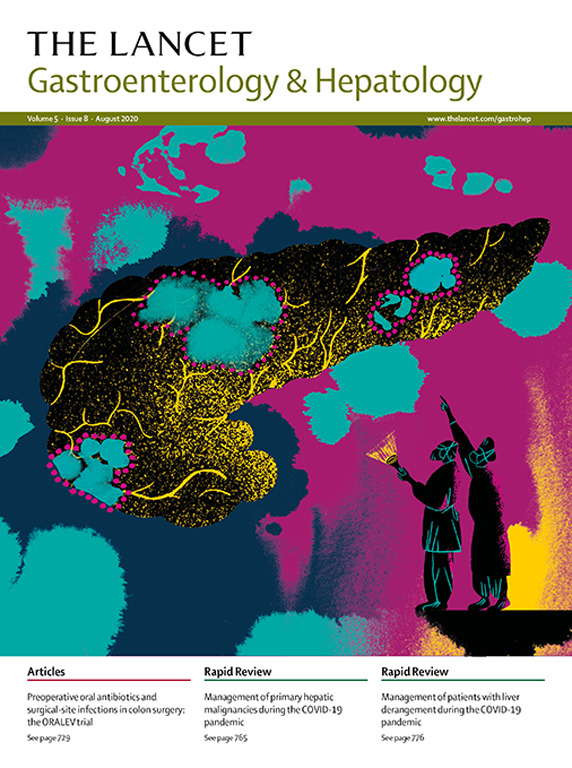Anti-TL1A antibody, afimkibart, in moderately-to-severely active ulcerative colitis (TUSCANY-2): a multicentre, double-blind, treat-through, multi-dose, randomised, placebo-controlled, phase 2b trial
IF 38.6
1区 医学
Q1 GASTROENTEROLOGY & HEPATOLOGY
引用次数: 0
Abstract
Background
TNF-like ligand 1A (TL1A) is an emerging therapeutic target for inflammatory bowel disease. We evaluated the safety and efficacy of multiple doses of afimkibart, a TL1A-directed antibody, in patients with moderately-to-severely active ulcerative colitis.Methods
The multicentre, double-blind, treat-through, multi-dose, randomised, placebo-controlled, phase 2b, TUSCANY-2 trial was conducted at 114 centres in 23 countries across North America, Europe, Asia, Africa, Australia, and South America. Adults (aged 18–75 years) with moderately-to-severely active ulcerative colitis (total Mayo score [tMS] 6–12, endoscopic subscore ≥2) were randomly assigned (2:2:2:2:2:3:1:1:1) to one of nine treatment sequences to receive subcutaneous afimkibart 50 mg, 150 mg, 450 mg, or matched placebo every 4 weeks during the 12-week induction period, and subcutaneous afimkibart 50 mg, 150 mg, or 450 mg during the treat-through 40-week maintenance period. Investigators and patients were masked to treatment. Study drugs were administered by masked site personnel following preparation by an unmasked pharmacist at the investigational site. Efficacy was assessed at weeks 14 and 56 in the intent-to-treat populations. The primary efficacy endpoint of clinical remission at week 14 by tMS (defined as tMS ≤2, with no individual subscore >1) was assessed in those who received at least one dose of drug or placebo during induction, excluding patients who had missing data due to complications resulting from COVID-19. Safety endpoints were also analysed in those who were randomly assigned and received at least one dose of assigned treatment. This study is registered with ClinicalTrials.gov, NCT04090411.Findings
Between Dec 19, 2019, and Oct 25, 2022, 246 patients were randomly assigned treatment, of whom 245 were treated, 228 completed induction, and 178 completed maintenance. Median age was 39 years (IQR 30·0–51·0), 99 (40%) patients were female and 146 (60%) were male; median disease duration was 4·7 years (IQR 2·5–10·2). At week 14, the primary endpoint of clinical remission by tMS was reported in 12 (26%) of 47 patients in the afimkibart 50 mg group (risk difference vs placebo [RD] 13·9% [90% CI –0·2 to 27·7]; p=0·0545), 14 (23%) of 60 patients in the afimkibart 150 mg group (RD 11·7% [–1·7 to 24·1]; p=0·0823), and 21 (24%) of 88 patients in the in the afimkibart 450 mg group (RD 12·2% [–0·6 to 22·9]; p=0·0642) versus five (12%) of 43 patients in the placebo group. In alignment with updated US Food and Drug Administration guidance, clinical remission using the modified Mayo score at week 14 was reported in 14 (30%) of 47 patients in the afimkibart 50 mg group (RD 18·2% [90% CI 3·3 to 32·2]), 21 (35%) of 60 patients in the in the afimkibart 150 mg group (RD 23·4% [6·2 to 36·3]), and 28 (32%) of 88 patients in the in the afimkibart 450 mg group (RD 20·2% [3·2 to 31·3]) versus five (12%) of 43 patients in the placebo group. Overall, 117 (48%) of 245 patients in the induction phase and 132 (59%) of 224 patients in the maintenance phase reported at least one treatment-emergent adverse event; incidences of treatment-emergent adverse events during induction were similar with placebo and afimkibart. The most common treatment-emergent adverse events (occurring in ≥5% of patients) during induction were nausea, urinary tract infection, ulcerative colitis, anaemia, fatigue, headache, and pyrexia. Six serious adverse events were reported during induction in the active treatment groups and four in the placebo group. Two patients who completed induction and did not receive the study drug during maintenance had serious adverse events during safety follow-up. During the maintenance period, 12 (5%) of 224 patients had 13 serious adverse events. No deaths occurred.Interpretation
Differences in the primary endpoint of clinical remission by tMS were not significantly different for any dose of afimkibart compared with placebo. However, secondary endpoints suggest that afimkibart was associated with a favourable benefit–risk profile, with clinically meaningful improvements in clinical remission with the modified Mayo score for patients with moderately-to-severely active ulcerative colitis. These results support the continued development of afimkibart.Funding
Pfizer, Roivant Sciences, and F Hoffmann-La Roche.抗tl1a抗体afimkibart用于中度至重度活动性溃疡性结肠炎(tuscanyon -2):一项多中心、双盲、全治疗、多剂量、随机、安慰剂对照的2b期试验
tnf样配体1A (TL1A)是炎症性肠病的新兴治疗靶点。我们评估了多剂量afimkibart(一种tl1a导向抗体)在中度至重度活动性溃疡性结肠炎患者中的安全性和有效性。该多中心、双盲、贯穿治疗、多剂量、随机、安慰剂对照、2b期tuscany2试验在北美、欧洲、亚洲、非洲、澳大利亚和南美的23个国家的114个中心进行。患有中度至重度活动性溃疡性结肠炎的成年人(年龄18-75岁)(梅奥总评分[tMS] 6-12,内镜下亚评分≥2)被随机分配(2:2:2:2:3:1:1:1:)到9个治疗序列中的一个,在12周的诱导期内每4周接受皮下阿菲基巴特50 mg、150 mg、450 mg或匹配的安慰剂,在治疗至40周的维持期内皮下阿菲基巴特50 mg、150 mg或450 mg。调查人员和患者被蒙面接受治疗。研究药物由蒙面的现场人员在研究现场由一名未蒙面的药剂师配制后给药。在第14周和第56周对意向治疗人群进行疗效评估。在诱导期间接受至少一剂药物或安慰剂的患者中,评估了第14周tMS临床缓解的主要疗效终点(定义为tMS≤2,没有个体亚评分>;1),排除了因COVID-19引起的并发症而丢失数据的患者。对随机分配并接受至少一剂指定治疗的患者的安全性终点也进行了分析。本研究已在ClinicalTrials.gov注册,编号NCT04090411。在2019年12月19日至2022年10月25日期间,246例患者被随机分配治疗,其中245例接受治疗,228例完成诱导,178例完成维持。中位年龄39岁(IQR 30·0 ~ 51·0),女性99例(40%),男性146例(60%);中位病程为4.7年(IQR为2.5 ~ 10·2)。在第14周,阿菲基巴特50 mg组的47名患者中有12名(26%)报告了经tMS临床缓解的主要终点(与安慰剂的风险差异[RD] 13.9% [90% CI - 0.2至27.7];p=0·0545),阿菲基巴特150 mg组60例患者中有14例(23%)(RD 11.7%[-1·7 ~ 24.1];p= 0.0823),阿菲基巴特450 mg组88例患者中有21例(24%)(RD为12.2% [- 0.6 ~ 22.9];P = 0.0642),而安慰剂组43例患者中有5例(12%)。符合美国食品和药物管理局的指导更新,使用修改后的梅奥临床缓解得分14在14周的47名患者(30%)afimkibart 50毫克组(RD 18·2% (90% CI 3·3 - 32·2]),21日的60名患者(35%)在afimkibart 150毫克组(RD 23·4%[6·2 36·3]),和28(32%)的88名患者afimkibart 450毫克组(RD 20·2%[3·2 31·3])和5(12%),安慰剂组43例。总体而言,245例诱导期患者中有117例(48%)和224例维持期患者中有132例(59%)报告了至少一次治疗引起的不良事件;诱导过程中出现的治疗不良事件的发生率与安慰剂和阿非基巴特相似。诱导过程中最常见的治疗不良事件(≥5%的患者发生)是恶心、尿路感染、溃疡性结肠炎、贫血、疲劳、头痛和发热。在诱导过程中,积极治疗组报告了6例严重不良事件,安慰剂组报告了4例。两名完成诱导且在维持期间未接受研究药物的患者在安全随访期间出现严重不良事件。在维持期内,224例患者中有12例(5%)发生13次严重不良事件。没有人员死亡。解释:与安慰剂相比,任何剂量的阿非基巴特在经颅刺激缓解的主要终点上的差异都没有显著性差异。然而,次要终点表明,阿菲基巴特具有良好的获益-风险特征,对于中度至重度活动性溃疡性结肠炎患者,改良梅奥评分对临床缓解有临床意义的改善。这些结果支持了afimkibart的持续发展。资助辉瑞、罗文特科学和罗氏。
本文章由计算机程序翻译,如有差异,请以英文原文为准。
求助全文
约1分钟内获得全文
求助全文
来源期刊

Lancet Gastroenterology & Hepatology
Medicine-Hepatology
CiteScore
50.30
自引率
1.10%
发文量
0
期刊介绍:
The Lancet Gastroenterology & Hepatology is an authoritative forum for key opinion leaders across medicine, government, and health systems to influence clinical practice, explore global policy, and inform constructive, positive change worldwide.
The Lancet Gastroenterology & Hepatology publishes papers that reflect the rich variety of ongoing clinical research in these fields, especially in the areas of inflammatory bowel diseases, NAFLD and NASH, functional gastrointestinal disorders, digestive cancers, and viral hepatitis.
 求助内容:
求助内容: 应助结果提醒方式:
应助结果提醒方式:


